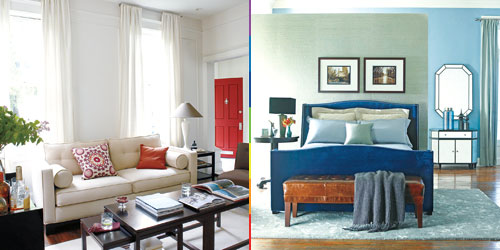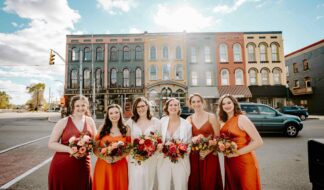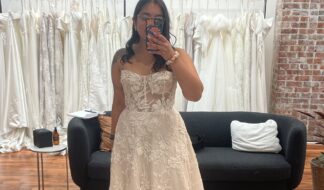by Jessica Carreras

Forget about La-Z-Boy. Mitchell Gold and Bob Williams, owners of a furniture store chain by the same name, have been dubbed the Kings of Comfort. And though the openly gay business partners didn't come up with the lofty title, they try to live up to it with their own abodes, and in their North Carolina-based company. It's even in the title of their 2009 book "The Comfortable Home."
But for Gold and Williams, comfort isn't just being soft or plush: it's owning a company that uses recycled materials, gives back to its community and knows that a luxurious life can be found both inside and outside your home.
You use the word comfort in both of your books and on your Web site. What are you trying to connote?
Mitchell Gold: When Bob and I started the company 21 years ago, one of the things we realized is that virtually no furniture manufacturer used the word comfort to describe furniture. It just wasn't a priority. Bob and I really like comfortable furniture, so we started using the word "comfort" and it really resonated with people. It was like we had invented a new word.
As we really got into it, we realized that comfort was more than just the way something sat, but it was the way something felt when you feel the arm or the back of it. And comfort is also when you look at the price and it's reasonable. So comfort for us is all-encompassing. We really think it's a word that describes what's important in our lives.
Going through "The Comfortable Home," it seemed very user-friendly. Was that the idea?
Bob Williams: One of the things that we want this book to do is really help people make good decisions when they start furnishing their home. One of the things that we really encourage is that for each room, really think about how you want to live and use the room. Is this going to be a room where people sit and watch TV? Is this going to be a place where you entertain friends and family? Because once you kind of decide what the purpose or function of the room is, it's a lot easier to find the right furnishings that will allow you to do what you want the room to do.
But decorating is hard. Where do you suggest people start when they're looking at their home and they're overwhelmed?
M.G.: That's really what the book is about: telling people how to get started and how to get organized. And a big part of what we say in the book is that a little bit of planning can really save you a lot of time and money in the long run. But we're also very honest and say that, you know, it's not real easy. You have to think about some things ahead of time. It just doesn't come together by snapping your fingers.
A lot of people, especially here in Michigan, are on a budget. Where do you absolutely recommend not going cheap?
B.W.: We strongly believe that with the pieces you use every day – things you're going to touch that are going to be a part of your life – you should really take your time and buy good quality pieces. Things that you can save a little bit of money on, but also be able to switch out, are some of the accessories; some of the bright, colorful things that actually will let you change the look and the feel of the room.
How does your latest book build off of your first book, "Let's Get Comfortable"?
M.G.: For the first book, Bob and I traveled all around the country and did book signings and events and really got to meet a lot of people who had read the book, and we got a lot of comments on it.
For example, people really like the idea of us showing them a room and then teaching them step-by-step how to put that room together. We have a lot more of that in this book. We also have a lot of floor plans in this book. So for a typical square living room, we give three or four different ways that you could do that room.
The photos are absolutely beautiful. Why such a strong focus on visuals?
M.G.: The reality is that we wanted to make it easy for people to look at a picture in this book, go into one of our stores and come pretty close to duplicating it. Bob and I, with a team of people, have put these rooms together, and it took some time to do that. We can save people time by just making it something they can look at and just say, "Wow, that's what I want."
There's a lot of use of flowers and greenery in the book – why is that?
M.G.: Just a little touch of flowers really makes a room warm up. In a lot of the pictures, they're faux flowers, because not everybody can afford to have fresh flowers all the time and water them.
Or keep them alive.
M.G.: Listen, I just killed a cactus in New York (laughs).
Is that possible?
M.G.: I don't know how that happened!
There were a lot of dogs in this book, too.
B.W.: I think pets are a big, important part of a lot of people's lives. It's amazing – probably one of the most-asked questions we have is, "How do I deal with my dog or my cat in the house as far as wear and tear and things like that?" We really want people to know that we have the same problems as everybody else. We've got dogs in our house, cats, and how do you deal with them?
You vacuum a lot.
B.W.: You're absolutely right.
In the introduction to the book, there's a lot more than just decorating. Why is all of this extra stuff – being green, your nonprofit childcare in North Carolina, equality for LGBT employees – so important to include?
M.G.: We've found that people really like understanding who they're buying from and understanding who we are. It all comes together to make somebody comfortable. When somebody has our furniture and our design in their home and they get into a conversation with someone and start talking about our daycare or our health care program or our pets, it puts a smile on their face.
I also noticed that two of the homes featured are owned by gay couples. Was that a concern at all?
M.G.: No, it's just a fact of life. How we came to the homes is that we had a contest that we put out to thousands and thousands of people and had people submit their homes. And it's just the way it worked out.
One of the most important things Bob and I have done in the community where we live in North Carolina, where the factory is, is that we are just who we are. We're not trying to make a big political statement, but we're not hiding anything either. We just are who we are. And that's what gets people to understand that gay people are –
B.W.: Not that much different. Houses might be a little nicer, though.
They're nicer than mine, but I'm working on it.
M.G.: Well, we're here to help you.










